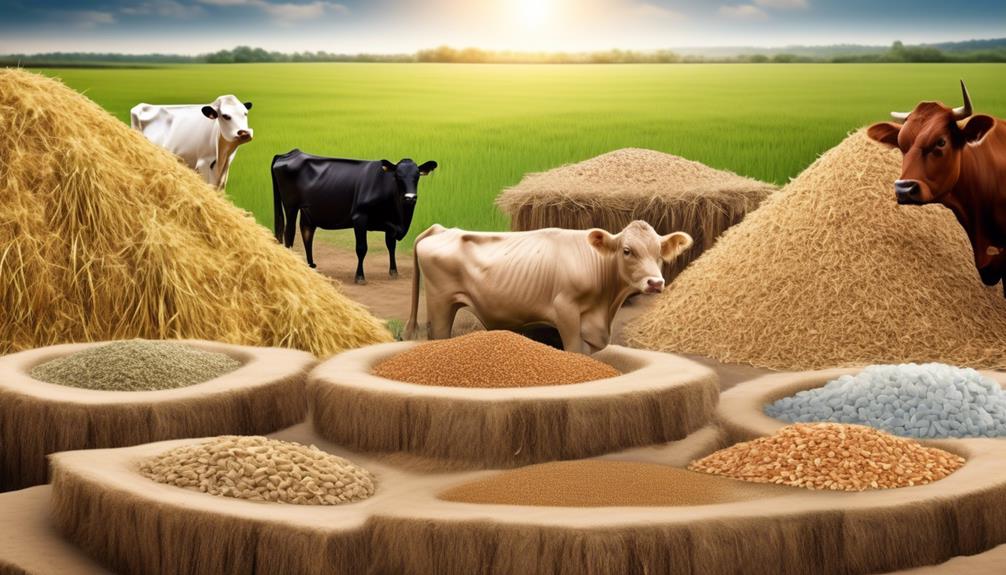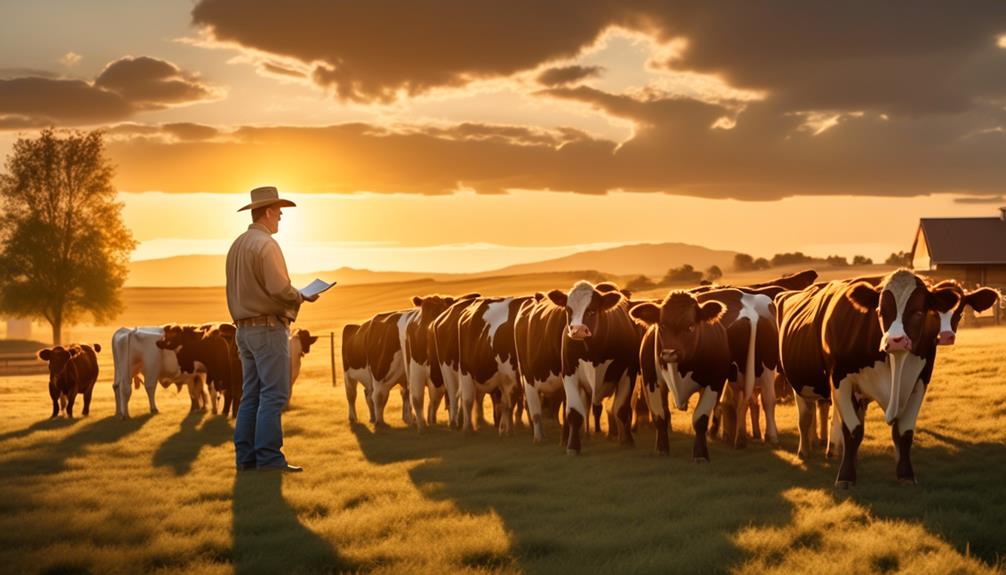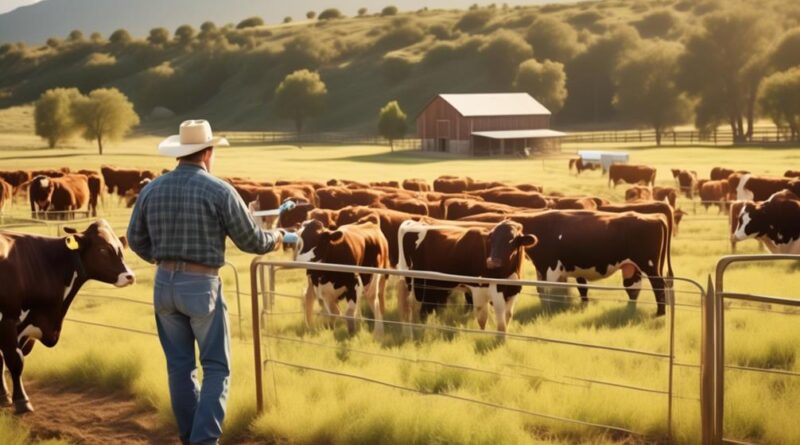11 Essential Cattle Health Management Tips
If you are a cattle owner, you are part of a significant industry that contributes over $67 billion to the U.S. economy annually. But keeping your herd healthy and productive can be a challenging task.
You might be aware of some common health management practices, but there are 11 essential tips that can significantly impact the overall well-being of your cattle. From nutrition and vaccination to disease prevention and emergency preparedness, these tips are crucial for the success of your operation.
So, how can you ensure that your cattle are thriving and disease-free?
Nutrition and Diet

When managing the health of your cattle, it's crucial to ensure they've a balanced and nutritious diet. Feeding practices play a vital role in maintaining the well-being of your cattle. It's important to provide them with high-quality forage, such as grass and hay, to meet their nutritional needs. Additionally, supplementing their diet with dietary supplements can help address any deficiencies and ensure they receive all the necessary vitamins and minerals.
To optimize your cattle's feeding practices, it's essential to understand their nutritional requirements at different stages of life. For example, lactating cows require a diet rich in energy and protein to support milk production, while growing calves need a diet that promotes healthy development. By tailoring your feeding practices to meet these specific needs, you can support the overall health and productivity of your herd.
Dietary supplements can also play a crucial role in maintaining the health of your cattle. These supplements can include minerals like calcium, phosphorus, and copper, as well as vitamins A, D, and E. However, it's important to consult with a veterinarian or nutritionist to determine the appropriate supplements for your herd based on their specific dietary needs.
Vaccination Schedule
Establish a vaccination schedule for your cattle to ensure their ongoing health and protection against common diseases. Vaccinations play a crucial role in preventing various infectious diseases that can significantly impact the health and productivity of your herd. Here are some essential tips to consider when planning your cattle's vaccination schedule:
- Consult with a veterinarian: Work closely with a veterinarian to develop a tailored vaccination schedule based on the specific needs and risks associated with your herd. A professional assessment will ensure that the vaccinations are administered at the most effective times and provide the necessary protection.
- Vaccination effectiveness: Keep track of the effectiveness of each vaccine by monitoring disease incidence within your herd. This information will help you evaluate the success of the vaccination program and make any necessary adjustments.
- Herd immunity: Understanding the concept of herd immunity is crucial for effective vaccination. By ensuring a high percentage of your herd is vaccinated, you can reduce the overall risk of disease transmission and protect individual animals that may not have developed a strong immune response to the vaccines.
Maintaining a well-planned vaccination schedule is vital for the overall health and productivity of your cattle. By staying informed about vaccination effectiveness and prioritizing herd immunity, you can create a robust defense against common diseases, ultimately leading to a healthier and more resilient herd.
Parasite Control
After establishing a vaccination schedule for your cattle to ensure their ongoing health and protection against common diseases, it's important to pivot to the critical topic of parasite control in order to maintain the overall well-being of your herd. Parasites can pose a significant threat to the health and productivity of your cattle.
One key aspect of parasite control is understanding and managing parasite resistance. Over time, parasites can develop resistance to common dewormers, rendering them ineffective. To combat this, it's crucial to work with your veterinarian to develop a strategic deworming program that minimizes the development of resistance. Rotating between different classes of dewormers and conducting regular fecal egg counts to monitor the effectiveness of the treatment are essential components of parasite resistance management.
In addition to strategic deworming, grazing management plays a vital role in parasite control. By implementing practices such as rotational grazing and maintaining optimal stocking densities, you can help reduce the risk of parasite transmission. Rotational grazing allows pastures to rest between grazing periods, which can help break the parasite lifecycle by interrupting their access to hosts. Furthermore, avoiding overgrazing and ensuring proper drainage in pastures can minimize the risk of parasite infestation in your herd.
Monitoring Body Condition
To ensure the health of your cattle, regularly assess their body condition using visual and tactile evaluation methods. Monitoring body condition is crucial for effective weight management and overall herd health. Here are some key points to consider:
- Body Condition Scoring: Implement a body condition scoring system to objectively evaluate the fat cover and muscle development of your cattle. This will help you track their nutritional status and make informed decisions regarding their diet and overall care. A body condition scoring scale typically ranges from 1 to 9, with 1 being emaciated and 9 being obese. Aim to maintain your cattle within the ideal range of 5 to 7 for optimal health and productivity.
- Visual Assessment: Regularly observe the body shape and overall appearance of your cattle. Look for signs of excessive fat deposits or prominent skeletal features, as these indicators can help identify potential weight management issues. Additionally, pay attention to any changes in body condition over time, as fluctuations may signal underlying health concerns.
- Tactile Evaluation: Use your hands to feel the fat cover and muscle tone of your cattle. This hands-on approach allows for a more detailed assessment of body condition, enabling you to detect subtle changes that may not be immediately apparent through visual inspection.
Proper Housing and Facilities
Ensuring proper housing and facilities for your cattle is essential for their well-being and productivity. When it comes to barn design, consider a layout that provides ample space for each animal to move comfortably. Adequate ventilation is crucial to minimize the buildup of moisture and ammonia, which can lead to respiratory issues. Additionally, ensure that the barn is well insulated to protect your cattle from extreme temperatures. A well-designed barn helps in maintaining the health of your cattle and can contribute to higher productivity.
Another crucial aspect of proper housing is providing clean and high-quality water. Water quality directly impacts the overall health of your cattle. Ensure that the water sources are free from contaminants and regularly check for any signs of pollution. Proper water quality can help prevent diseases and improve the overall well-being of your cattle.
In addition to barn design and water quality, it's important to regularly assess the overall condition of your cattle housing and facilities. Repair any damaged structures, maintain clean and dry bedding, and ensure that feeding areas are organized and easily accessible. Regular maintenance and upkeep of the housing and facilities contribute to the health and comfort of your cattle.
Disease Prevention
Maintain a proactive approach to disease prevention by implementing strict biosecurity measures and vaccination protocols for your cattle. Disease prevention is crucial for the overall health and well-being of your herd. By following these essential tips, you can minimize the risk of disease outbreaks and ensure the productivity of your cattle operation.
- Implement Comprehensive Biosecurity Measures: Create and enforce a robust biosecurity plan to prevent the introduction and spread of diseases within your herd. This includes controlling access to your farm, quarantining new animals, and regularly disinfecting equipment and facilities. Additionally, consider limiting visitors and vehicles on your property to reduce the risk of disease transmission.
- Establish a Vaccination Protocol: Work closely with your veterinarian to develop a tailored vaccination schedule for your cattle. Vaccines play a critical role in preventing common infectious diseases such as respiratory infections, clostridial diseases, and reproductive diseases. Stay informed about the latest vaccine developments and ensure that all cattle receive timely and appropriate vaccinations.
- Conduct Regular Disease Surveillance: Implement a routine disease surveillance program to monitor the health status of your herd. This involves regular health checks, diagnostic testing, and prompt reporting of any unusual symptoms or behaviors. Early detection of diseases can prevent widespread outbreaks and minimize the impact on your cattle's health and productivity.
Reproductive Health

As you focus on the health of your cattle, prioritizing reproductive health is essential for ensuring the long-term success of your herd. Breeding management and fertility testing are crucial aspects of maintaining reproductive health in your cattle. Regular fertility testing allows you to identify and address any potential issues that could affect the breeding success of your herd. By conducting fertility tests, you can ensure that your cattle are in optimal reproductive condition, ultimately leading to better breeding outcomes.
Maintaining hormonal balance is also critical for ensuring the reproductive health of your cattle. Hormonal imbalances can lead to irregular estrus cycles and decreased fertility. Monitoring and managing the hormonal balance of your cattle can help in optimizing their reproductive capabilities. Additionally, estrus detection plays a vital role in successful breeding management. Being able to accurately detect estrus in your cattle allows for timely breeding, increasing the chances of conception and successful pregnancies.
Incorporating a well-planned breeding management program into your cattle health management strategy is essential. This involves closely monitoring the reproductive health of your herd, implementing appropriate breeding techniques, and ensuring that your cattle are in optimal condition for successful breeding. By prioritizing reproductive health through breeding management, fertility testing, hormonal balance, and estrus detection, you can contribute to the long-term sustainability and productivity of your cattle herd.
Emergency Preparedness
In the event of an emergency, promptly assess the safety and well-being of your cattle to ensure their welfare and minimize potential risks. Being prepared for unexpected situations is crucial for every cattle owner.
Here are some essential tips for emergency preparedness:
- Emergency Response Plan: Develop a comprehensive emergency response plan that includes procedures for different scenarios such as severe weather, fire, or disease outbreak. Ensure that all employees or family members involved in cattle care are familiar with the plan and know their roles and responsibilities.
- First Aid Kit: Keep a well-stocked first aid kit readily available. Include items such as bandages, antiseptic solution, wound dressings, and medications recommended by your veterinarian. Regularly check the kit to ensure that all supplies are up to date and in good condition.
- Animal First Aid Training: Equip yourself and others responsible for the cattle with the knowledge and skills required for providing animal first aid. Training in basic wound care, administering medications, and recognizing signs of distress or illness can make a significant difference in emergency situations.
It's important to remember that a quick and effective emergency response can greatly impact the well-being and recovery of your cattle. By having a well-thought-out plan, access to proper first aid supplies, and the necessary training, you can better ensure the safety and health of your livestock in times of crisis.
Frequently Asked Questions
How Can I Train My Cattle to Use a Specific Feeding Area?
To train your cattle to use a specific feeding area, try using positive reinforcement with treats or feed. Gradually introduce the area and guide them to it. Consistency and patience are key in these training techniques to modify their feeding behavior.
What Are the Signs of Anemia in Cattle and How Can It Be Prevented?
To prevent anemia in cattle, focus on nutrition. Watch for symptoms like pale gums, weakness, and poor growth. Ensure their diet includes enough iron, copper, and B vitamins. Regular veterinary check-ups are essential for maintaining cattle health.
Is There a Recommended Method for Identifying and Treating Foot Problems in Cattle?
When identifying foot problems in cattle, inspect regularly for lameness, swelling, or abnormal gait. Treatment involves proper hoof trimming, managing environmental conditions, and addressing any underlying issues such as infections or injuries. Regular hoof care is essential.
How Can I Prevent Heat Stress in My Cattle During Hot Weather?
To prevent heat stress in your cattle during hot weather, focus on preventing dehydration and improving ventilation in shelters. Provide access to shade, plenty of fresh water, and consider using fans or misters to keep your cattle cool.
What Are Some Effective Methods for Controlling Flies and Other Pests in Cattle Housing Facilities?
To control flies and pests in cattle housing facilities, you can use fly traps, clean up manure regularly, and consider using feed-through insecticides. These methods help keep your cattle comfortable and healthy.
Conclusion
Overall, managing the health of your cattle is essential for their well-being and productivity.
By focusing on proper nutrition, vaccination, parasite control, and regular monitoring, you can ensure that your cattle are healthy and thriving.
Don't forget to prioritize disease prevention, reproductive health, and emergency preparedness to keep your herd in top condition.
With these essential tips, you can ensure the health and success of your cattle operation.
